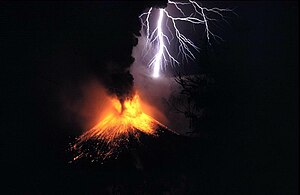
Image via Wikipedia
If you combined osis, coni, volcano, silico, microscopic, ultra and pneumono into a single word - the result is a name of a lung disease. And from doing it you can also improve the rate of your reading skills after you mastered the seven words.
I was surfing the net when I spotted the word Pneumonoultramicroscopicsilicovolcanoconiosis accidentally. So I have to look it from dictionaries and encyclopedias available online for its meaning – and the word is defined as a lung disease caused by the inhalation of very fine silica dust, mostly found in volcanos. It was originally coined simply to serve as the longest English word but has been used in several sources as an approximation of its originally intended definition. The name generally used to describe this condition is pneumoconiosis, which is much shorter.
The word Pneumonoultramicroscopicsilicovolcanoconiosis was originated from the seven words that has its own meaning such as:
- pneumono which is related to lungs (Latin, from Greek)
- ultra which is beyond (Latin, as in “ultraviolet”)
- microscopic which is extremely small (Latin/Old English, from Greek mikron, small, and skopos, view)
- silico which is silica (Latin)
- volcano which also volcano (Latin)
- coni which related to dust (Greek: konis, dust) and
- osis (Greek) which is disease or condition
The plural of this word is equally long – pneumonoultramicroscopicsilicovolcanoconioses. This 45-letter word, referred to by logologists as, first appeared in the Oxford English Dictionary in 1936, and has also since appeared in the Webster’s Third New International Dictionary, the Random House Dictionary of the English Language, Unabridged, and Merriam-Webster’s Collegiate Dictionary and Medical Dictionary.
But critics of its designation as the longest word complained that it is a technical term and not worthy of consideration as the longest word in general usage. It was said also that the word was originally intended as a hoax. Researchers discovered that the word was invented in 1935 by Everett M. Smith, president of the National Puzzlers’ League, at their annual meeting.
The word occurred in a newspaper headline about the meeting, after which it was picked up by an author of puzzle books. Members of the National Puzzlers’ League then campaigned to have it included in major dictionaries, eventually succeeding with the Oxford English Dictionary and Webster’s Third New International Dictionary.
So are you ready to rate your reading speed through this word? The technique is simple – first try to master the seven words and combine them into a single word and then say it from slow to faster pace.



No comments:
Post a Comment